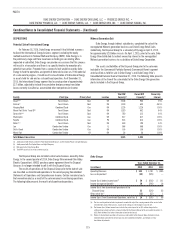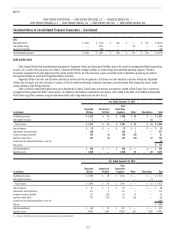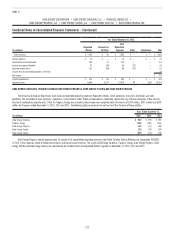Duke Energy 2015 Annual Report Download - page 133
Download and view the complete annual report
Please find page 133 of the 2015 Duke Energy annual report below. You can navigate through the pages in the report by either clicking on the pages listed below, or by using the keyword search tool below to find specific information within the annual report.
113
PART II
DUKE ENERGY CORPORATION • DUKE ENERGY CAROLINAS, LLC • PROGRESS ENERGY, INC. •
DUKE ENERGY PROGRESS, LLC. • DUKE ENERGY FLORIDA, LLC. • DUKE ENERGY OHIO, INC. • DUKE ENERGY INDIANA, INC.
Combined Notes to Consolidated Financial Statements – (Continued)
On July 23, 2013, North Carolina House Bill 998 (HB 998 or the North
Carolina Tax Simplification and Rate Reduction Act) was signed into law. HB 998
repealed the utility franchise tax effective July 1, 2014. The utility franchise tax
was 3.22 percent gross receipts tax on sales of electricity. The result of
this change in law is an annual reduction in excise taxes of approximately
$160 million for Duke Energy Carolinas and approximately $110 million for
Duke Energy Progress. HB 998 also increases sales tax on electricity from 3
percent to 7 percent effective July 1, 2014. HB 998 requires the NCUC to adjust
retail electric rates for the elimination of the utility franchise tax, changes due
to the increase in sales tax on electricity, and the resulting change in liability of
utility companies under the general franchise tax.
Foreign Currency Translation
The local currencies of most of Duke Energy’s foreign operations have
been determined to be their functional currencies. However, certain foreign
operations’ functional currency has been determined to be the U.S. dollar, based
on an assessment of the economic circumstances of the foreign operation.
Assets and liabilities of foreign operations whose functional currency is not
the U.S. dollar are translated into U.S. dollars at the exchange rates in effect at
period end. Translation adjustments resulting from changes in exchange rates
are included in AOCI. Revenue and expense accounts are translated at average
exchange rates during the year. Remeasurement gains and losses arising from
balances and transactions denominated in currencies other than the local
currency are included in the results of operations when they occur.
Dividend Restrictions and Unappropriated Retained Earnings
Duke Energy does not have any legal, regulatory or other restrictions on
paying common stock dividends to shareholders. However, as further described
in Note 4, due to conditions established by regulators in conjunction with merger
transaction approvals, Duke Energy Carolinas, Duke Energy Progress, Duke
Energy Ohio and Duke Energy Indiana have restrictions on paying dividends or
otherwise advancing funds to Duke Energy. At December 31, 2015 and 2014, an
insignificant amount of Duke Energy’s consolidated Retained earnings balance
represents undistributed earnings of equity method investments.
NEW ACCOUNTING STANDARDS
The new accounting standards that were adopted for 2015, 2014 and
2013 had no material impact on the presentation or results of operations,
cash flows or financial position of the Duke Energy Registrants. The following
accounting standards were adopted by the Duke Energy Registrants during 2015.
Reporting Discontinued Operations. In April 2014, the Financial
Accounting Standards Board (FASB) issued revised accounting guidance for
reporting discontinued operations. A discontinued operation would be either (i)
a component of an entity or a group of components of an entity that represents
a separate major line of business or major geographical area of operations
that either has been disposed of or is part of a single coordinated plan to be
classified as held for sale or (ii) a business that, upon acquisition, meets the
criteria to be classified as held for sale.
For Duke Energy, the revised accounting guidance is effective on a
prospective basis for qualified disposals of components or classifications as
held for sale that occurred after January 1, 2015. Under the standard, the
guidance is not effective for a component classified as held for sale before
the effective date even if the disposal occurs after the effective date of the
guidance. Duke Energy has not reported any discontinued operations under the
revised accounting guidance.
Balance Sheet Classification of Deferred Taxes. In November 2015, the
FASB issued revised accounting guidance for the Balance Sheet classification
of deferred taxes. The core principle of this revised accounting guidance is that
all deferred tax assets and liabilities should be classified as noncurrent. For
Duke Energy, this revised accounting guidance was adopted prospectively for
December 31, 2015. The Balance Sheet as of December 31, 2014, does not
reflect this reclassification of current deferred tax assets and liabilities. See
Note 22 for further information on the impact from adoption of this accounting
standard.
Balance Sheet Presentation of Debt Issuance Costs. In April and
August 2015, the FASB issued revised accounting guidance for the presentation
of debt issuance costs. The core principle of this revised accounting guidance
is that debt issuance costs are not assets, but adjustments to the carrying
cost of debt. For Duke Energy, this revised accounting guidance was adopted
retrospectively to December 31, 2014.
The implementation of this accounting standard resulted in a reduction
of Other within Regulatory Assets and Deferred Debits and in Long-Term Debt
of $170 million and $152 million on the Consolidated Balance Sheets as of
December 31, 2015 and 2014, respectively.
Fair Value Disclosures for Certain Investments. In May 2015, the
FASB issued revised accounting guidance for investments in certain entities
that use net asset value per share (or its equivalent) as a practical expedient
to determine fair value. The core principle of this revised accounting guidance
is that the valuation of investments using the practical expedient should not be
categorized within the fair value hierarchy (i.e., as Level 1, 2 or 3). The practical
expedient applies to investments in investment companies for which there is
not a readily determinable fair value (market quote) or the investment is not in
a mutual fund with a publicly available net asset value. For Duke Energy, this
revised accounting guidance was adopted retrospectively.
The implementation of this guidance is reflected in Note 16: Fair Value
Measurements and Note 21: Employee Benefit Plans.
The following new accounting standards have been issued, but have not
yet been adopted by the Duke Energy Registrants, as of December 31, 2015.
Revenue from Contracts with Customers. In May 2014, the FASB
issued revised accounting guidance for revenue recognition from contracts with
customers. The core principle of this guidance is that an entity should recognize
revenue to depict the transfer of promised goods or services to customers in an
amount that reflects the consideration to which the entity expects to be entitled
in exchange for those goods or services. The amendments in this update also
require disclosure of sufficient information to allow users to understand the
nature, amount, timing and uncertainty of revenue and cash flows arising from
contracts with customers.
For the Duke Energy Registrants, this guidance is effective for interim and
annual periods beginning January 1, 2018, although it can be early adopted for
annual periods beginning as early as January 1, 2017. The guidance can be
applied retroactively to all prior reporting periods presented or retrospectively
with a cumulative effect as of the initial date of application. Duke Energy is
currently evaluating the requirements. The ultimate impact of the new standard
has not yet been determined.
Financial Instruments Classification and Measurement. In January
2016, the FASB issued revised accounting guidance for the classification
and measurement of financial instruments. Changes in the fair value of all
equity securities will be required to be recorded in net income. Current GAAP
allows some changes in fair value for available-for-sale equity securities to be
recorded in AOCI. Additional disclosures will be required to present separately
the financial assets and financial liabilities by measurement category and form
of financial asset. An entity’s equity investments that are accounted for under
the equity method of accounting are not included within the scope of the new
guidance.
























